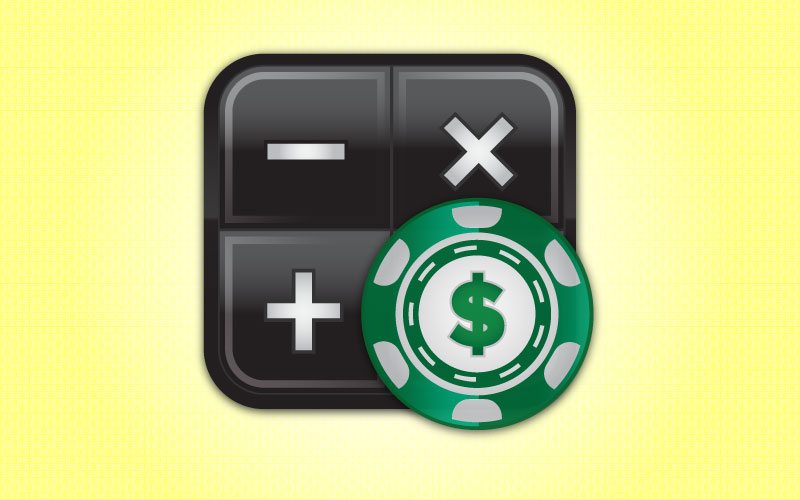Contents
- 1. Introduction to Hand Combinations
- 2. How to Calculate Possible Combinations of a Pocket Pair Hand
- 3. How to Calculate Possible Combinations of a Non-Pocket Pair Hand
- 4. Brief Discussion of Blockers
- 5. Effect of Blockers on a Villain’s Range with Example Calculations
- 6. Some Additional Applications of Blockers
- Leave a Comment Below!
1. Introduction to Hand Combinations
There are 1326 possible pocket hands in hold’em if you assume that something like A  A
A  is the same hand as A
is the same hand as A  A
A  , which it is. We get this number by saying there are 52 ways to draw the first card, 51 ways to draw the second card, and divide that product of 52 and 51 by 2 since we’re assuming A
, which it is. We get this number by saying there are 52 ways to draw the first card, 51 ways to draw the second card, and divide that product of 52 and 51 by 2 since we’re assuming A  A
A  is the same as A
is the same as A  A
A  . Statistically, it’s more likely for you to be dealt AK than AA, and more likely for you to be dealt AA than AKs, and so quite obviously a study of the combinatorics of starting hands can be useful for developing a more accurate understanding of the development of ranges during a hand.
. Statistically, it’s more likely for you to be dealt AK than AA, and more likely for you to be dealt AA than AKs, and so quite obviously a study of the combinatorics of starting hands can be useful for developing a more accurate understanding of the development of ranges during a hand.
In this post I’m going to cover what I consider to be the most important topics on the subject. First, I’m going to show you the fastest way to calculate how likely it is for someone to be dealt certain hands. Second, I’m going to show you how to put this into practical use with a discussion of blockers.
I would like to note that this is a lot easier than most people make it, and with just a few minutes of practice, you will be able to tell me in about two seconds that it’s equally as likely for someone to be dealt AA or KQ if the flop comes KQQ.
2. How to Calculate Possible Combinations of a Pocket Pair Hand
If you randomly choose two cards from a deck, there are six different ways to make a single pocket pair. If you examine the possible ways you can be dealt 55, for example, you come up with 5  5
5  , 5
, 5  5
5  , 5
, 5  5
5  , 5
, 5  5
5  , 5
, 5  5
5  , and 5
, and 5  5
5  . For each pocket pair, there are the same combinations of suits.
. For each pocket pair, there are the same combinations of suits.
Intuitively we can figure out that on a flop of AK2, Villain having QQ is more likely than Villain having AA. Similarly, on a flop of 885, Villain having 55 is more likely than Villain having 88. The question that most people can’t answer is: how much more likely is one hand than another? To answer this question, I’m going to ask you to remember a number, and it’s the only thing I’m going to ask you to memorize in this entire post. The number I need you to remember is: 6310.
Here is how you use this number to determine pocket pair combinations. If we are asking how many combos of AA there are, and we see no Aces in our hand or on the board, then there are 6 possible combinations of AA, just like we stated earlier. However, if there is 1 Ace in our hand or on the board, then there are 3 possible combinations of AA that a Villain can have. If there are 2 Aces in our hand or on the board, then (quite obviously) there is 1 possible combination of AA that a Villain can have. And finally, if there are 3 Aces in our hand or on the board, then (again, quite obviously) there are 0 possible combinations of AA that a Villain can have.
So suppose we hold KT on a board of AAQJ7, and we want to know how many combinations Villain could have of AA, QQ, or 22. We can see two Aces exposed, so there is 1 possible combination of AA that Villain could have. We can see one Queen exposed, so there are 3 possible combinations of QQ that Villain could have. Finally, there are no Twos exposed, so there are 6 possible combinations of 22 that Villain could have.
For another example, suppose we hold 44 on a flop of AJ4. There are 3 ways Villain could have AA, 3 ways Villain could have JJ, 6 ways Villain could have KK, and 0 ways Villain could have 44.
For our final example, suppose we hold AK preflop. There are 3 ways Villain could have AA, 3 ways Villain could have KK, and 6 ways Villain could have QQ. (This ties in with our discussion of blockers later on, but note that it’s because of this that AK is only a 40/60 dog against QQ+, AK).
3. How to Calculate Possible Combinations of a Non-Pocket Pair Hand
There are sixteen different ways to be dealt a non-pocket pair starting hand in hold’em because there are four possible suits for the first card and four possible suits for the second card, and we all know that four times four is sixteen. In light of this, it’s not complicated to figure out how many possible combinations of a non-pocket pair starting hand there are.
The first step is to figure out how many of each card is left in the deck. For example, if we want to know how many combinations of AK our opponent could have, then we want to know how many Aces and Kings are left in the deck. The second step is to simply multiply these two numbers together.
For example, if I want to know how many combinations of QJ an opponent could have when we hold AJ on a flop of JT4, then I note that there are 4 Queens left in the deck and 2 Jacks left in the deck, so there are 8 possible combinations of left QJ that a Villain could have.
For another example, if I want to know how many combinations of AK an opponent could have when we hold AQ on a board of AKQ53, then first I see that there are 2 Aces and 3 Kings left in the deck. Therefore, there are 2×3 = 6 possible combinations of AK that a Villain could have.
4. Brief Discussion of Blockers
When you hold a blocker, you hold a card that makes it less likely for an opponent to have a specific starting hand. For example, if in hold’em you hold A5s before the flop, it’s half as likely that a specific opponent is dealt AA than if you held KQ or KK or 87s. There are other examples as well, such in 2-7 single draw if you are dealt 22277 then it’s much less likely that an opponent was dealt a pat 7 (75432, 76432, 76532, or 76542).
This is very intuitive, but the effects of blockers are often misrepresented and misunderstood, which is why I’ve added the following onto this post about starting hand combinations.
5. Effect of Blockers on a Villain’s Range with Example Calculations
Suppose that in some preflop scenario, we hold A3s and Villain’s range is {QQ+, AK}. That gives him 12 possible combinations of AK, 6 of QQ, 6 of KK and 3 of AA, for a total of 27, and 33.33% of that range is KK+. If instead, we held JJ, then Villain would have 16 possible combinations of AK, 6 of QQ, 6 of KK and 6 of AA, for a total of 34, and 35.3% of that range would be KK+. The point is that blockers have the potential to weaken our opponents’ ranges significantly.
For the fun part (an example calculation for understanding blockers) I’m going to look at a fun 3-bet bluffing scenario:
Suppose with 100bb stacks, Villain 4x opens a range of {22+, AQ+} from early position. If we assume that Villain only continues against a 3-bet with {JJ+, AK}, then how often does Villain fold if we hold 87s? A4s?
If we hold 87s, then there are 104 hands combinations that make up {22+, AQ+}. Villain continues with {JJ+, AK}, which is 40 combinations. This means that Villain continues 38.5% of the time, and that Villain folds 61.5% of the time.
If we hold A4s, then there are now only 96 hand combinations that make up {22+, AQ+} since we’re taking away 3 possibilities each for AA and 44, and 4 possibilities each for AQ and AK. Villain continues with {QQ+, AK}, which is now only 27 combinations. This means that when we hold A5s, Villain continues just 28.1% of the time, and folds 71.9% of the time.
If we assume Villain opened for 4x in EP and we 3-bet to 12x in LP, we need Villain to fold 68.6% of the time to break even just from our fold equity. Against the exact same ranges from our Villain, A4s was a guaranteed +EV bluff while 87s was not because of the blocker.
6. Some Additional Applications of Blockers
Visit the FTR Poker Forum and read more.
Leave a Comment Below!
Submit your review | |









